PinotFile: 6.2 October 23, 2006
|
Wishful DrinkingOnly those dedicated Pinot drinkers with fat wallets can drink really good (and usually expensive) Pinot Noir frequently. Most of us wish for a well-crafted, artisanal, complex, thoroughly enjoyable Pinot that we can stock our cellar proudly with at around a Jackson a bottle. Wishful thinking you say? Read on. Aubin Cellars is an extension of Jérôme Aubin’s passion for wine and his years of experience in the wine industry. He has imported French oak barrels from Rousseau of Burgundy and Saint-Martin of Bordeaux for the last twelve years. Aubin visits more than 250 wineries in the United States and Canada annually and has developed a personal vision of the style of wine he wants to produce. A number of years ago, he met Fred Scherrer when Fred was the winemaker at Dehlinger, and Aubin helped him to run his barrel program. When Aubin founded Aubin Cellars in 2001, he enlisted Scherrer to craft the initial four vintages of Aubin Cellars Pinot Noir. I reviewed the 2002 Aubin Cellars Verve Russian River Valley Pinot Noir in the PinotFile (Volume 4, Issue 16) and found it to be quite good, “a Dehlinger knockoff worth seeking out.”  In 2005, Jerome Aubin decided to make his wine in Oakland near his residence and enlisted the services of Loren Tayerle to make the wines. Tayerle’s background includes training in Viticulture and Enology at University of California Davis and Napa Valley College and winemaking positions at David Bruce Winery and Rosenblum Cellars Scherrer crafted the 2004 Aubin Cellars Russian River Valley Pinot Noir and Tayerle made the 2004 Aubin Cellars Sonoma Coast Pinot Noir. In 2006, two tons of Pinot Noir were crushed in Oregon and added to the portfolio of wines. A Columbia Valley (Washington State) Syrah is available now, and in 2007, there will be a California Syrah. The vineyard sources for the grapes for Aubin Cellars wines cannot be revealed due to contractual obligations. Each of the appellation wines are from two or three different vineyards to insure complexity in the final blend. The wines are made in very small lots (not exceeding 2 tons of grapes) in a very hands-on fashion. 100% de-stemmed. Fermentation is carried out in small open top stainless steel fermenters. The must is hand-pressed using a basket press. The wines are aged an average of 17 months in 40% new French barrels (Rousseau and Francois Freres). The wines are bottle aged six months before release. The wines from Aubin Cellars are actually labeled “Verve.” This is a catchy noun that means energy or vitality in the expression of artistic ideas. The labels also feature beautiful pieces of art which fits the theme of creative enthusiasm nicely.
 2004 Verve Sonoma Coast Pinot Noir 14.5% alc., 150 cases, $22. 80% Sonoma Coast fruit from a vineyard close to the Pacific Ocean and 20% Carneros Swan clone fruit. Vine age averages six years. Harvested at average 25° Brix. The label artist is Michelle Bonnetain of France. · This is an amazingly pure wine of great vim and vigor. The nose is perfumed beautifully with cranberry, cherry, spice and vanilla oak notes. There are more flavors here than Baskin Robbins: plump crushed cherries, herb tea, mocha, and a little earthiness. My notes say excellent (which is underlined) and that pretty much sums it up. A complete wine and the best California Pinot Noir I have tasted this year for around $20. Jackson would be proud. Pledge allegiance.
 2004 Verve Russian River Valley Pinot Noir 14.5% alc., 160 cases, $27. This wine is from a premium vineyard in the Russian River Valley with vines averaging ten years in age. Harvested at average 26° Brix. The label artist is Gerard Schneider of France. · I love the aromatics which feature bright red cherries, Xmas spices and a little bit of what the French call “ca sent la merde.” With air time, the wine improves noticeably, the texture becoming smooth and the cherry cola fruits explode on the palate. Medium-bodied and nicely balanced, this Pinot finishes with lively acidity that is searching for some good food.
Aubin Cellars Verve, 6050 Colton Blvd, Oakland, CA 94611. The phone is 866-353-7398. The wine may be purchased through the website at www.aubincellars.com. Retail distribution is primarily in Northern California. There is a mailing list signup on the website.
Jekel Vineyards Pinot NoirThe Jekel Vineyards Monterey County Pinot Noir carries the theme of value Pinot Noir quite proudly. Bill Jekel , who founded Jekel Vineyards in 1972, was a tireless advocate for the potential of Monterey County to produce world-class wines. Now owned by Brown-Forman, Jekel Vineyards has a really credible 2005 Pinot Noir made in large quantities and readily affordable.
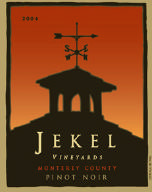 2005 Jekel Vineyards Monterey County Pinot Noir 13.5% alc., 15,000 cases, $15. Winemaker Charlie Gilmore has taken fruit from well known vineyards like Jekel’s Gravelstone Vineyard and blended in a touch of fruit from the Sonoma Coast. The wine is fermented primarily in neutral barrels. The website is www.jekel.com There is widespread retail distribution. · The theme for this Pinot is dark stone fruits, both in the nose and palate. There are some attractive spice and herbal notes as well. The wine is well-endowed and rich. Surprisingly, there are detectable smoky oak flavors despite the frugal use of new oak. The finish is lacking in some intensity and length but at this price it is hard to be picky. The wine was released in September and is widely available in the retail market. A solid daily-drinker.
Martinborough Cult Wine : Dry RiverMuch of the excitement about New Zealand Pinot Noir has been wines from Central Otago and Marborough, both in the South Island. But many enthusiasts feel the Martinborough region in the southern portion of the North Island shows the most potential for delivering Burgundian character in Pinot Noir. Several notable producers have released impressive Pinot Noirs from here in recent years including Ata Rangi, Craggy Range, Hidden Valley, Margrain Vineyard, Martinborough Vineyard, Martinus Estate, Pallisar Estate, Stratford, Te Kairanga, and Voss Estate. The approximately 900 acres of Pinot is small in comparison to the amount of acreage in Central Otago and Marlborough, but the quality is high. In the Aussie wine magazine, Gourmet Traveller Wine, of the top 2003 New Zealand Pinot Noirs tasted and rated, four of the top six wines came from Martinborough, Not all who taste them, however, are applauding. The style is typical rich, dense and fruit-driven and often veers more toward a big red wine than a Pinot Noir in character. Michael Steinberger notes, “For the moment they suggest the New World more than Burgundy; they are, in other words, fruit-driven and high in alcohol, extract and oak.” I try to sample as much New Zealand Pinot Noir as I can get my hands on. This is a difficult task, for although exports are rising quickly (the United States will become the #1 export market for New Zealand within five years), the number of Pinot Noirs reaching our shores is quite spotty and often less than 100 cases of a wine shows up here. I recently ran across a Dry River Martinborough Pinot Noir, referred to as a “cult” wine by at least one writer in the United States and priced accordingly ($70). Dry River was the name of one of the oldest Wairapa sheep stations in New Zealand, dating to 1877. It was later renamed Dyerville, and it was near here in 1979 that Neil and Dawn McCallum planted a vineyard. This area has come to be known as the Martinborough Terrace, located just across the Huangarua River from Te Muna. The Martinborough Terrace appellation has the lowest rainfall on the North Island, a cool-climate appropriate for growing Pinot Noir, and free-draining gravelly soils. There are now more than twenty-five labels originating from this special terroir. In 2002, the winery and 30 acres of vineyards were sold to New York businessman Julian Robertson and California winegrower Reg Oliver who owns El Molino Winery in St. Helena, California. The new owners have infused cash into the operation for expansion and updated equipment. Neil McCallum continues as Chief Winemaker with Katie Hammond assisting. Two features of vineyard management at Dry River contribute to the style here. No irrigation is employed, despite the low rainfall, causing roots to go very deep for nutrients, stressing the vines, and producing small berries with concentrated flavors. Secondly, crop thinning at veraison is employed to severely limit yields. Neil McCallum makes no apologizes for his resulting style: “My suspicion is that New Zealand and cool maritime climates could have a large impact on the world perception of what Pinot Noir is capable of, although it will take some time before the new styles are completely accepted because Burgundy has been center stage for so long. Our own terroir can yield a predominance of plump, exuberant fruit flavors - to a fault in some instances, but they can also be rich and complex varietal statements. Add concentration and longevity to this, and great wines are possible.” 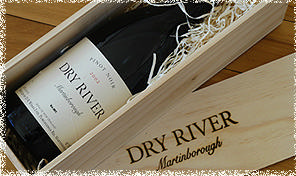
2003 Dry River Martinborough Pinot Noir 13% alc., $70, numbered bottles. The 2003 vintage at Dry River was very dry and yields were small. The fruit for this wine was harvested at 1.2 tons per acre. McCallum notes that in a recent vertical tasting of Dry River Pinot Noirs, the 1989 through 1991 vintages were still showing extremely well. Proper cellaring will be rewarded. Bob Campbell, MW, said it best: “This wine is not a fruit bomb - it’s a time bomb.” · The color is a strikingly dark violet. A deep, rich nose features ripe cherries, raspberries, vanilla and smoke. The mouth feel is very big and plush with generous amounts of sweet fruit. The finish is clean and lengthy and echoes licorice, dark stone fruits, and pleasing oak. The wine has a great backbone of acidity and tannins. This Pinot noir has a very powerful charisma.
The wine is imported by RO Imports, LLC, St. Helena, California (www.rowines.com). The winery’s excellent and informative website is www.dryriver.co.nz. My source was www.winex.com.
Pinot Rage vs Pinot EnvyIf you had to bet money, would you put it on sommeliers or winemakers to see who could craft the best wine? A year ago, the Carneros Wine Alliance brought some of the Bay Area’s most notable sommeliers and wine and food professionals to Carneros for a day to harvest and process Pinot Noir. The grapes came from the vineyards of Gloria Ferrer and the Sangiacomo Family Vineyards. The group of sommeliers and wine and food professionals made their wines at Acacia Vineyards and Mac- Rostie Winery and Vineyards. These two wineries also made their own Pinot Noirs from the same grapes under the supervision of their winemakers. The inaugural “Cru Carneros” event was intended to show young wine professionals what was involved in making fine wine. The fledgling vintners were divided into two groups and after harvest, followed their wines through the winemaking process for a year until bottling. Wineries providing support viticulturists and winemakers for the event included Bouchaine, Buena Vista Carneros, Ceja Vineyards, Cuvaison, Etude, Saintsbury, and The Donum Estate. 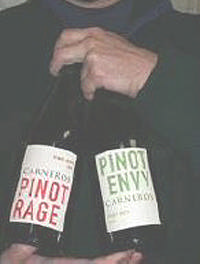 The wines made by the two sommelier and wine and food professional teams were labeled “Pinot Rage” and “Pinot Envy.” This month, a panel of wine professionals, including Peter Marks, MW, Director of Wine, Copia, Sean Foster, winemaker at Merryvale Vineyards, and Anne Moses, Patz & Hall co-winemaker blind tasted and judged the wines made by the sommelier and wine and food professionals as well as the two wines made by trained winemakers. The event was held at Domaine Carneros. The spirit of the event was educational. There were no actual numerical scores, rather a discussion of the structure and qualities of each of the wines. The wines were all enjoyed during the dinner that followed the tasting. The wines made by the group from Cru Carneros I were distributed to those who made them, each receiving a three-pack. The Cru Carneros Class Two will focus on cool climate Merlot and will draw sommeliers, wine directors, and food and beverage professionals from all over the United States.
First Mechanical Harvest at Fox HollowI received a really interesting note from Bryan at Fox Hollow Vineyards in southwest Michigan. At the end of April, there was a bad frost in Michigan which decimated the grapes. Many vines were frosted down to the tertiary bud. They made the decision to leave four canes versus two on their vertical shoot position trellis in order to get something out of the Pinot Noir this year. Needless to say, this was not a good decision. With the excessive leaf to grape ratio, the plants preferentially went into a vegetative state, shutting down production of many grape clusters. The end result was plenty of leaves and tiny grapes. Obtaining migrant labor during harvest is a challenge in Michigan. This year at Fox Hollow they were faced with the dilemma of spending considerable money on labor to pick a couple tons of Pinot Noir (667, 777, 115 on Riparia and 101-14) over three or four days versus dropping the crop and forgetting about it. Brix levels were 21° and the grapes were beginning to break down. September had been extremely wet (more rain in southwest Michigan than in any of the previous sixteen years that Bryan has lived there). Lo and behold, they found out that one of the local Concord growers had leased a modern French harvester which uses high speed vibration with soft paddles. Bryan chose to try the harvester on his crop and was able to go through 2 ½ acres in 1 hour 20 minutes (at $150 per hour excluding travel time for the harvester and support tractors). Bryan was nice enough to share some photos of the harvest which I think will be of great interest to readers.
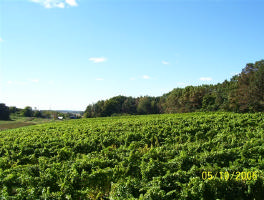 Here is a photo of Bryan’s Pinot Noir and Gewürztraminer vineyards to the southwest. The hills in the distance are the dunes of Lake Michigan.
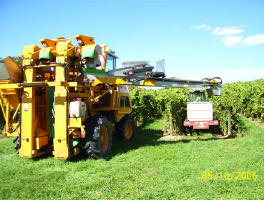
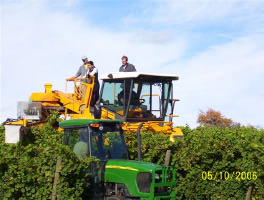
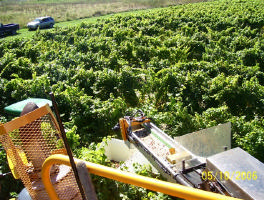 The grapes from Fox Hollow Vineyard go to Round Barn Winery, owned by Rich Moersch (PinotFile, Volume 5, Issue 26). Hopefully I will get a follow up report on how the 2006 Pinot Noir turned out.
THE WINE MAKERS TV Show Chooses CastBeginning October 25, 2006, THE WINE MAKERS will debut on public television. The twelve participants have been chosen. All of them have a passion for wine, but have no professional wine making experience. Over 600 applicants applied via auditions across the United States. Over the course of eight episodes, they will be exposed to every side of the wine industry, from winegrowing to sales, and marketing. Their ultimate goal is to win the chance to create and launch their own wine brand. The list includes: Allan Bass (restaurant owner), Stephanie Hervey (business analyst and entrepreneur), Ross Outon (wine and spirits store manager), Taylor Senatore (editor of wine website), Sara Livermore (server in a wine bar in Calistoga, CA), Brothers James and Daniel Darden (wine steward and wine bar attendant in Napa Valley, respectively), Julia Roberts (master gardener), Viral Hazari (marketing executive for a semi-conductor company), Eryn Supple (grocery buyer for natural food store), Lauren Tomasino (manager of wine and spirits store), and Barbara Cray (attorney). Six participants are from California and the remainder call seven other states home. Executive producers Jennifer Levine and Kevin Whelan plan to have participants undergo a series of challenges with the assistance of industry advisors. The challenges will be judged by a group of experts in the world of wine and food. The host of the series will be Brian Von Dedenroth, a noted host, reporter and editor for travel news and entertainment programs in California.
Kanzler Vineyards Pinot Noir DebutsKanzler Vineyard is the one of the hottest (not literally) Pinot Noir vineyards among Pinot Noir lovers. Planted by Stephen and Lynda Kanzler in 1996, just west of the town of Sebastopol in the Sonoma Coast appellation, it has quickly become a magical source for fine Pinot Noir. Pinot Noirs crafted by A.P. Vin, CL Wines, Kosta Browne, Rhys Vineyards and Roessler, among others, have caught the fancy of the wine press. The 2004 Kosta Brown Kanzler Vineyard Pinot Noir garnered an outrageous score of 98 in the Wine Spectator. Years ago, it was Williams Selyem that pushed Rochioli Vineyard to stardom and Kosta Browne has done that for Kanzler Vineyard.  The Kanzler Vineyard is located on an east-facing slope of a small valley on what was formerly an apple orchard. The site has Goldridge sandy loam soils, and the vines prosper from the cool, foggy nights, sunny days, and afternoon maritime breezes. Clones 667, 115 and Pommard are planted on appropriate rootstock for this location. The Kanzlers are passionate grape farmers who are never far from the action as they live in a house on the vineyard property. In 2004, the Kanzlers partnered with winemaker Greg Stach to make their own wine. Greg Stach is a Fresno State trained winemaker (1992) who has stints at Landmark Vineyards and Pellegrini Family Vineyards on his resume (photo right).
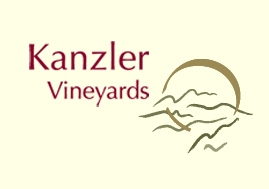 2004 Kanzler Vineyards Sonoma Coast Pinot Noir 14.7% alc., $35. · Classy wax closure. This is a light to medium bodied Pinot which has a caressing texture. The aromatics feature cherries, cranberries, rhubarb, and a little smoke. This has more restraint and elegance as compared to the Kosta Browne bottling. Over time, the oak and alcohol can peek out on the finish, but with food this Pinot is magical. I had this wine with grilled, marinated tri-tip and whole grain Texmati brown and red rice with grilled veggies. This Pinot really softens and integrates with food and isn’t this what wine is really for?
This is a label to watch based on the quality of the grapes from this vineyard and the rising talent of Greg Stach. The current website at www.kanzlervineyards.com is under construction but check back to sign up for the mailing list. The phone number is 707-824-1726. For retail distribution, check www.wine-searcher.com,
More on Screw CapsDean Linebarger writes that he was in Burgundy earlier this year and while visiting Patrice Rion, noted that screw caps were being used for some of his white wines and his Bourgogne Rouge. The screw caps he is using are a new technology which allow a slight amount of breathing similar to a cork. Rion noted that his screw cap wines always sell much faster than the same wine with corks. Mark Wills sent a screw cap alert from Australia. Rumor at the Barossa Valley Wine Show was that Penfolds is going to bottle Grange under Stelvin from the 2006 vintage onwards. He also noted that he has some Nicholas Laroche Chablis L’Obedience (close to his top bottling) from the 2002 vintage under screw cap. I could never figure out a suitable use for the thousands of corks I have saved. Now what am I going to do with all of these screw caps? Help!
Fine Wine Auctions Take Different Forms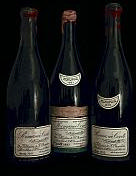 On October 20-21, 2006, Acker Merrall & Condit held a record-breaking auction of rare wine in New York City. Over 94% of lots were sold for a gross of $24.4 million dollars, easily breaking the previous auction world record of $14.4 million dollars. The wines were from an incredible cellar of a personal collector and represented probably the greatest cache of rare wine in the world. 24 lots went for over $100,000! Examples: 4 magnums 1962 La Tache DRC $101,575.00, 12 bottles 1947 Chateau Petrus $101,575.00, 12 bottles 1959 Musigny G. Roumier $107,550.00, 1 Methuselah 1978 Romanee Conti DRC $125,475.00, 6 magnums 1962 Musigny Vielles Vignes Comte de Vogue $149,375.00, 6 magnums 1945 Chateau Mouton Rothschild $155,350.00 and 12 bottles 1990 Romanee Conti DRC $161,325.00. These amounts do not include an 18.5% Buyer’s premium as well as a 1% insurance premium to cover the wines while in storage. A full listing of realized prices of the auction are at www.ackerwines.com. At the other end of the auction spectrum is CellarExchange.Com. This internet auction site was started by North Carolinian Doug Parsons, an advertising sales executive and long time wine enthusiast. This unique site allows buyers and sellers of fine and rare wines to match up without any buyer’s or seller’s fees. This is a nonprofit venture so far for Doug, but is fueled by his love of the hobby of wine collecting. Over 2,200 buyers and sellers are registered in his database. Bidding is similar to that conducted on eBay and Wine Commune. If you are outbid on a lot before the auction is over, you are notified by e-mail so you can enter a higher bid if you wish. The site also offers swapping capability. If you have some wine that you are tired of drinking, you can post your offerings and your preferences for wines you are willing to trade for. The site also offers free wine appraisals and free hammer price searches. The website is www.cellarexchange.com. |